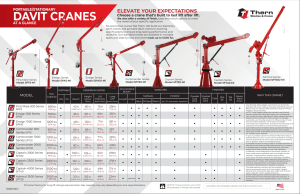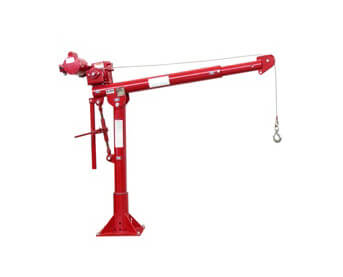The Basics of Load Capacity in Davit Cranes
Load capacity — the maximum load a crane can lift under ideal conditions — is critical to understanding which is the best davit for any job. First and foremost, load capacity is not fixed. Factors like lift angle, and lift height, unstable ground, environmental conditions, and boom and mast length all play a part in determining the load capacity of each lift. Davit cranes are a great solution for many lifting, lowering, and positioning tasks, but to pick the right one, you need to understand how these variables can impact your crane’s performance and safety. For this article, let’s dive into how lift height and boom length will impact your davit.
How Boom Length Influences Load Capacity
The short and sweet rule of thumb for boom length is that the longer your boom, the lower the load capacity will be. A longer boom will increase the amount of leverage applied to the crane, reducing the amount of weight it can safely and effectively lift. For instance, if your davit is rated for 5,000 lbs, it should be able to lift that amount of weight with the boom fully retracted and in ideal circumstances. However, if the boom is extended, even under those same ideal circumstances, the capacity could drop by a significant amount — up to thousands of pounds.
Balancing Reach and Capacity
There are a few common setups that can serve as starting points for working out which davit crane is best for your job. If you have heavy loads, a short boom that can be angled more vertically is ideal. If you’re moving lighter weights but require extra reach, a davit with an extendable boom can do the job even if it won’t be able to lift to the crane’s maximum capacity.
When choosing a davit, be sure to make a thorough evaluation of your space, reach requirements, and maximum load that the crane will ever lift. If you find that your needs are just on the edge of needing a higher capacity crane, the safest bet is to go with the larger load capacity.
Engineering Calculations and Load Ratings
By now, it is obvious that load ratings aren’t static numbers that will remain the same across all situations. The good news is that you can get a solid understanding of load ratings for various boom lengths, angles, and lifting heights based on the crane’s product sheet. While these sheets won’t cover every single possible position of the crane, they will give you excellent insight into how load capacities shift as the boom position changes.
For custom crane installations, an engineering review is vital for ensuring that load capacity and safety concerns are properly addressed.
Matching Equipment to Application
Getting the right davit for your job is hugely important for getting the best performance out of your equipment and ensuring the safety of everyone on the site — and you clearly can’t forget about your boom positioning when it’s time to make a crane choice. Have a qualified person evaluate your site so you have a clear understanding of your requirements. That way, whether you need maximum reach or maximum lifting capacity, you can choose the davit with the right boom capabilities. If you have questions throughout the process, don’t hesitate to get in touch with the experts at Thern — we’d be happy to help you find the right davit for your application.

